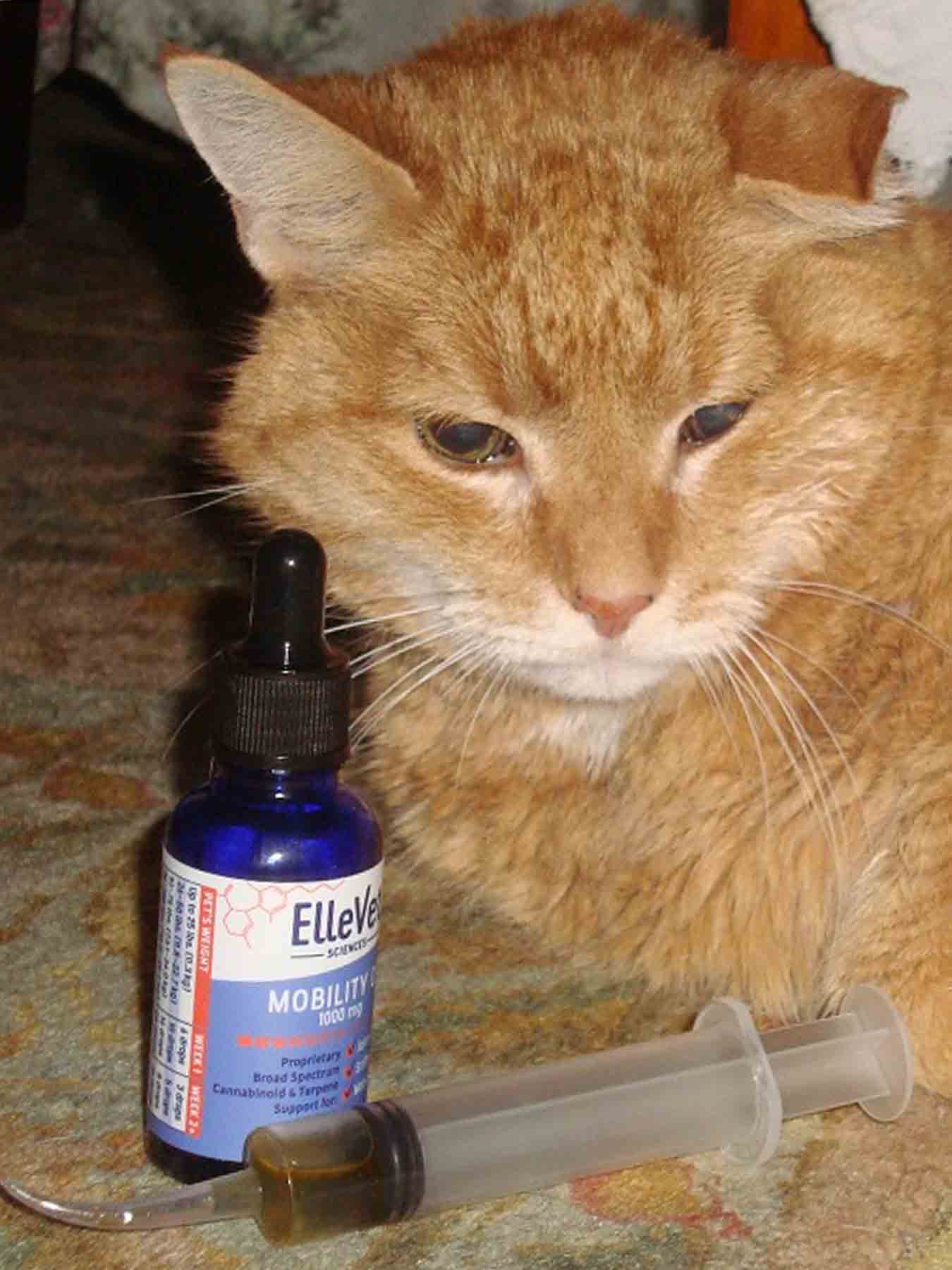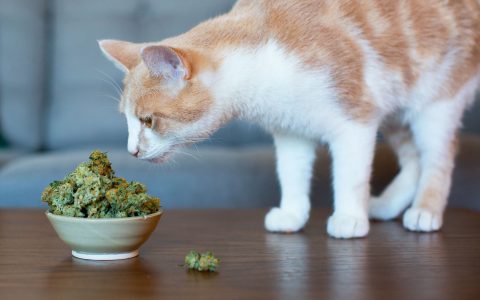There’s a lot of conflicting information out there about treating pets with cannabidiol (CBD) oil.
As journalist and pet owner I was skeptical about giving CBD to animals.
Maple tussles with coyotes, raccoons, and dogs. But age is catching up to him.
There are few studies to consult. Most of the information is anecdotal. But recently when Maple, my family’s very old house cat, began to have seizures we decided to try a CBD treatment. My information is anecdotal, too, but maybe it’ll help you inform your own decision about whether the treatment is right for your cat. Here’s how it went for us.
 Maple is a survivor: 18 years of raccoon encounters and coyote tussles. He wears his war wound like a crown.(Courtesy of Bruce Kennedy)
Maple is a survivor: 18 years of raccoon encounters and coyote tussles. He wears his war wound like a crown.(Courtesy of Bruce Kennedy)
Meet Maple the Cat
Maple turns 18 this summer. He’s an orange tabby we adopted as a kitten. He likes to snooze in what we call “dead-bug” position—on his back, paws in the air—and has a long history of getting himself into trouble. He’s tangled with coyotes, raccoons, snakes and feral dogs. His most prominent feature is his broken-down and notched left ear, a souvenir from a dispute he settled with our second cat soon after her introduction to the household. Maple is a survivor.
Senior Issues, Then Seizures
As with humans, dogs and cats can get dementia as they age. About a year ago, along with arthritis, Maple began to yowl for no reason, sometimes in the middle of the night. We could deal with that (sort of), but several weeks ago we became alarmed when he began to have seizures.
In the beginning there were at least two a day. They would begin with him collapsing. His eyes would go glassy. Then would come the shaking and rolling: his body convulsing and corkscrewing into agonizing positions while he snapped, snarled and clawed at the air.
After about 90 seconds the tremors would subside. Maple’s eyes would clear, his body would eventually relax, and he’d start panting and would yowl pathetically. It would take several more minutes for him to get to his feet, and he’d sway like a drunk on a bender until his balance came back. We’d often have to clean up the blood from his bitten tongue, as well as saliva and urine.
 Maple recovering from a seizure, just before we started one of his early CBD treatments. (Courtesy of Bruce Kennedy)
Maple recovering from a seizure, just before we started one of his early CBD treatments. (Courtesy of Bruce Kennedy)
Advice From Our Vet
Our local veterinarian is very good with cats. He said that we could have Maple undergo a standard treatment, starting with a neurological exam and blood work. But given Maple’s advanced age, he suggested that we instead try CBD oil.
We could do blood work and tests, but the vet suggested trying CBD oil first.
The doctor told us he’s been recommending hemp-derived CBD oil for the past eight months or so, mostly for dogs with arthritis or anxiety issues. We live in suburban Denver, where cannabis has been legal for adults since 2012. “People around here are very open to it,” he said. “In fact sometimes that’s the first thing we try, or I suggest we try.”
When I asked if there had been any reluctance from his clientele about using CBD for their companion animals, he was amused.
“Probably one out of every four of them, they’re taking CBD for themselves,” he laughed.
Dosing CBD
I trust my vet. He’s been treating our cats for years now. We decided to go with his recommendation and try CBD oil for Maple. But being a journalist means my trust is limited, so I also did a bit of research.
There are literally dozens of pet-oriented CBD products currently available online. I was overwhelmed by the choices. Having covered the cannabis industry for some time now, I’ve learned to be skeptical of any undocumented claims made by those selling medicinal cannabis products—even if they include glowing testimonials from ‘satisfied customers.’ It’s difficult to know which products are clean and reliable, or even which products actually contain CBD. In the end, we went with a product the veterinarian’s office carried.
In early June, several days after the seizures began, we put Maple on a twice-a-day dosage of Mobility Oil produced by ElleVet Sciences out of Portland, Maine. We starting with three drops per dose but quickly ramped up to six drops, as per the bottle’s instructions. Three drops gave Maple a 6.3mg dose of CBD, while six gave him 13.2 mg. (ElleVet’s recommended dosage is about 2 mg per kilogram of body weight for cats. Dogs metabolize CBD differently, so consult your vet and product label for that information.)
A Battle of Wills
The cat was not fond of the CBD oil. At all. After a couple of failed attempts with the dropper I found that mixing the drops into a little water and then squeezing it all into Maple’s mouth with an oral syringe ensured that most of the dosage actually got into the cat.
Personally, I like the earthy bitterness of cannabis as a flavor. But I can see why Maple might object to it.
According to the manufacturers this oil is a “broad spectrum cannabinoid & terpene” compound, which means it also has a strong earthy cannabis smell. I must admit I did try a drop of the oil myself, purely for educational purposes. And while I personally like the bitterness of cannabis as a flavor, I can see why a cat might object to it.
I had to hold Maple’s head up in one arm, his body supported in my lap, to give him his dose. Once he got a whiff of that distinct smell—a smell stronger than the cannabis tinctures I use—his nose would wrinkle and he’d bat down my syringe-holding hand. If you’ve ever tried to spoon-feed an unwilling human infant, you get the idea. The battle of wills would begin.
Maple and I have an understanding. I’ve been able to clip his claws for years with minimal fuss, and I’ve learned that if I calmly but strongly hold him in position for medicines he eventually calms down and accepts his fate.
But he really didn’t like the CBD oil, and I have some scabbed-over scratches on my hands as proof. After getting his dose he’d give me a disapproving scowl, leap from my lap and shuffle away. We do this twice a day now.
Not a Miracle, But…
The CBD oil had no immediate effect regarding the seizures but we did notice a marked improvement in Maple’s appetite, as well as his overall movement.
Over time we’ve seen progress with the seizures, too. Ten days into his course of treatment, Maple was down from two seizures a day to one seizure every two days. I wouldn’t consider that a miracle cure, but Maple’s quality of life has definitely improved.
 Ten days into his treatment, Maple’s seizures were reduced by 75%. (Courtesy of Bruce Kennedy)
Ten days into his treatment, Maple’s seizures were reduced by 75%. (Courtesy of Bruce Kennedy)
Studies Underway
I told our veterinarian about how the CBD appeared to be working. He pointed me towards the results of a newly-released study by Dr. Stephanie McGrath, a neurologist at Colorado State University’s James L. Voss Veterinary Teaching Hospital.
Dr. McGrath’s study was small, involving 16 dogs that suffered from seizures. Nine of the dogs were treated with hemp-derived CBD for 12 weeks, while the remaining seven were placed in a control group and given a placebo.
According to her research, 89% of the dogs that received CBD had a reduction in the frequency of their seizures.
“We saw a correlation between how high the levels of CBD oil were in these dogs with how great the seizure reduction was,” McGrath said in a CSU press release. “It’s really exciting that perhaps we can start looking at CBD in the future as an alternative to existing anticonvulsive drugs.”
Pushback From Veterinary Associations
During our consultations, our veterinarian was very open with his information about CBD and comfortable talking about its potential uses. But he also asked that his name not be used in this article, due to the controversial status of CBD within the mainstream of animal medicine.
The AMVA says ‘the available scientific evidence pertaining to use of CBD in animals is currently limited.’
According to a survey of more than 2,100 vets done last year by the Veterinary Information Network, 63% of respondents said they were asked by their clients at least monthly—and sometimes weekly or even daily—about cannabis products for their pets. Most of the veterinarians surveyed said they had “never been the ones to initiate the discussion” about cannabis products.
That being said, a large part of the veterinary community remains split about CBD—and many are still reluctant to recommend it as a treatment.
On its website, the American Veterinary Medical Association (AVMA) notes that while cannabis-derived products appear to have therapeutic promise “in areas such as the treatment of epilepsy and the management of pain and inflammation associated with osteoarthritis, the available scientific evidence pertaining to their use in animals is currently limited.”
Much of what is known, the AVMA statement continues, “is related to anecdotal or case reports or has been gleaned from studies related to use in humans, including the study of animal models for that purpose.”
Finding a Product That Helps
Curious about the company that produced Maple’s medicine, I contacted Amanda Howland, co-founder and chief branding officer at ElleVet Sciences. (ElleVet did not pay for this article, nor did the company supply any medicine or other consideration. They just happened to be linked in a chain of trust: I trust our vet and our vet trusted ElleVet products enough to stock them, so that’s the brand we went with.)
Howland told me she understands the position of the big veterinary organizations.
“Veterinarians are doctors and they’re protecting their patients,” she said, “and they would like to see evidence.”
Howland pointed to a clinical trial conducted by Cornell University. It was a double-blind placebo trial on dogs with multi-joint pain, which her company supported with a research grant and a supply of products. In that study, researchers found that more than 80% of the dogs had a significant or dramatically positive response to CBD treatment.
ElleVet is currently in the middle of a seizure study with researchers at the University of Florida (also using the company’s CBD products), as well as a handful of other research regarding pain management and oncology in dogs.
One of the primary problems right now, Howland said, is CBD’s booming popularity. There are a lot of products currently on the market with very differing and sometimes very low levels of CBD content, quality and potency.
“There are a lot of products out there that really aren’t very good,” Howland told me. “So we want people to talk to their veterinarians, and we want veterinarians to have a product that they can trust and that they can recommend. We like to keep a good relationship with the veterinarians and we like to keep pet owners talking to their veterinarians, to make sure that the dogs and cats are getting a product that is actually going to help them.”
Realistic, but Hopeful
It will take some time to see if Maple’s CBD regimen is truly helping him, and if so, if it’s sustainable in the long term. His seizure rates has dropped, but there’s no way to know if that would have happened without the CBD oil, or if there are other factors involved.
I do know this. Our goal is to lessen the suffering of this cat that we’ve loved for nearly two decades. And right now the CBD oil seems to correlate with a reduction in seizures and an improvement in appetite and mood. Emotions aside, I’m encouraged about the potential for CBD to gain mainstream professional acceptance as a therapeutic treatment for both humans and their companion animals. It’s not hurting, and it seems to be helping. For Maple and for us, that’s all that we ask.














